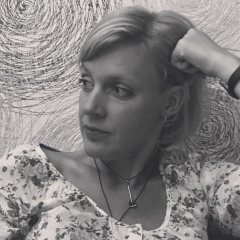#немоенопроменя
"А вот что первично со стороны терапевта — это:
???? Быть живым. Форма у «быть живым» может быть очень разная, но суть одна. «Все это прекрасно, Елизавета, но это вообще что такое, и как это проверить, чай, не диплом?» И таки если вы примерно это сейчас подумали, у меня нет для вас линейки, которая меряет «живость», но так или иначе она в терапевтическом контакте почувствуется. Там, где жизнь, есть движение. И если этого движения станет больше в жизни клиента (особенно если до был застой), значит, терапевт это умеет и может этому научить. Не в формате «Ой, меня так освежают горные лыжи/часовая медитация/поход в кинк-клуб по выходным, обязательно попробуйте!» - как раз убеждение, что все дело в горных лыжах подменяет суть на форму. Умение говорить «да» тому, что делает тебя самого живым (что бы это ни было — и это тоже важно, смелость честно посмотреть и признать, что же это такое) позволяет в целом говорить «да» жизни. И когда терапевт умеет это для себя, он сумеет и для клиента. «Да» тому, что делает тебя живым, даже если я этого никогда не пробовал и не понимаю. И здесь же — чуткость к тому, что притворяется живым, но на самом деле разрушает, глушит или умертвляет, даже если со стороны выглядит как супер-благо: да-да, ЗОЖ и духовность ради социально одобряемого самоистязания, я на вас смотрю!
???? Быть человеком во всей своей полноте. В том числе, страдать, бояться, ненавидеть, отчаиваться, не знать, быть жестоким, испытывать бессилие — и принимать это в себе. Но также и радоваться, наслаждаться, надеяться, веселиться, любить, доверять, заботиться, играть, мечтать. Терапевт, конечно, не идеал интегрированности всего на свете, высеченный в мраморе, но само его постоянное движение в сторону признания, принятия и интеграции самых разных проявлений себя (короче говоря, согласие с тем, что он, терапевт, всего лишь человек) важно. Тогда и человек, который сел в клиентское кресло, может проявлять себя во всей своей полноте, а терапевт не будет, сознательно или бессознательно, препятствовать этим проявлениям.
???? Умение сострадать. Слушать и взаимодействовать не только головой, но и душой. Быть с человеком не только аналитически, но и в чувствах. Открываться тому, чтобы быть затронутым чувствами — клиента или собственными, в ответ на историю клиента. Это опыт, который не заменяется на анализ или изучение теории с целью понять себя — разделить переживания. Благодаря ему к человеку порой могут вообще возвращаться чувства, с которыми он долго был не в контакте: например, там, где о болезненной истории человек рассказывает с иронией, терапевт своей реакцией может «вернуть» клиенту когда-то отсеченную боль, гнев, страх, чтобы, наконец, их прожить и сделать просто частью своего опыта, а не выгнанным от греха подальше в цементный подвал монстром.
Эти три точки взаимосвязаны. Сострадание без умения жить может превратиться в спасательство. Умение жить без сострадания — в гуруизм. Хорошая новость в том, что все это переплетается, и если «прокачивается» одно, оно неминуемо затрагивает и два других.
Быть живым, быть человеком, быть открытым и говорить «да» жизни и человечности другого. Вот без этого с терапией проблемы.
А дети, развод или еще какой кусок опыта — это вторично.
Но если кажется, что очень даже первично и жизненно важно — возможно, это повод для разговора о доверии, безопасности и надежде".
Елизавета Мусатова
Телеграм канал "Записки злого терапевта"
@therapyreal
"А вот что первично со стороны терапевта — это:
???? Быть живым. Форма у «быть живым» может быть очень разная, но суть одна. «Все это прекрасно, Елизавета, но это вообще что такое, и как это проверить, чай, не диплом?» И таки если вы примерно это сейчас подумали, у меня нет для вас линейки, которая меряет «живость», но так или иначе она в терапевтическом контакте почувствуется. Там, где жизнь, есть движение. И если этого движения станет больше в жизни клиента (особенно если до был застой), значит, терапевт это умеет и может этому научить. Не в формате «Ой, меня так освежают горные лыжи/часовая медитация/поход в кинк-клуб по выходным, обязательно попробуйте!» - как раз убеждение, что все дело в горных лыжах подменяет суть на форму. Умение говорить «да» тому, что делает тебя самого живым (что бы это ни было — и это тоже важно, смелость честно посмотреть и признать, что же это такое) позволяет в целом говорить «да» жизни. И когда терапевт умеет это для себя, он сумеет и для клиента. «Да» тому, что делает тебя живым, даже если я этого никогда не пробовал и не понимаю. И здесь же — чуткость к тому, что притворяется живым, но на самом деле разрушает, глушит или умертвляет, даже если со стороны выглядит как супер-благо: да-да, ЗОЖ и духовность ради социально одобряемого самоистязания, я на вас смотрю!
???? Быть человеком во всей своей полноте. В том числе, страдать, бояться, ненавидеть, отчаиваться, не знать, быть жестоким, испытывать бессилие — и принимать это в себе. Но также и радоваться, наслаждаться, надеяться, веселиться, любить, доверять, заботиться, играть, мечтать. Терапевт, конечно, не идеал интегрированности всего на свете, высеченный в мраморе, но само его постоянное движение в сторону признания, принятия и интеграции самых разных проявлений себя (короче говоря, согласие с тем, что он, терапевт, всего лишь человек) важно. Тогда и человек, который сел в клиентское кресло, может проявлять себя во всей своей полноте, а терапевт не будет, сознательно или бессознательно, препятствовать этим проявлениям.
???? Умение сострадать. Слушать и взаимодействовать не только головой, но и душой. Быть с человеком не только аналитически, но и в чувствах. Открываться тому, чтобы быть затронутым чувствами — клиента или собственными, в ответ на историю клиента. Это опыт, который не заменяется на анализ или изучение теории с целью понять себя — разделить переживания. Благодаря ему к человеку порой могут вообще возвращаться чувства, с которыми он долго был не в контакте: например, там, где о болезненной истории человек рассказывает с иронией, терапевт своей реакцией может «вернуть» клиенту когда-то отсеченную боль, гнев, страх, чтобы, наконец, их прожить и сделать просто частью своего опыта, а не выгнанным от греха подальше в цементный подвал монстром.
Эти три точки взаимосвязаны. Сострадание без умения жить может превратиться в спасательство. Умение жить без сострадания — в гуруизм. Хорошая новость в том, что все это переплетается, и если «прокачивается» одно, оно неминуемо затрагивает и два других.
Быть живым, быть человеком, быть открытым и говорить «да» жизни и человечности другого. Вот без этого с терапией проблемы.
А дети, развод или еще какой кусок опыта — это вторично.
Но если кажется, что очень даже первично и жизненно важно — возможно, это повод для разговора о доверии, безопасности и надежде".
Елизавета Мусатова
Телеграм канал "Записки злого терапевта"
@therapyreal
# non-exchange
"But what’s primary on the part of the therapist is:
???? To be alive. The form of “being alive” can be very different, but the essence is the same. “All this is wonderful, Elizabeth, but what is it all about, and how to check it, tea, not a diploma?” And yet, if you just thought about it now, I don’t have a ruler for you that measures “liveliness,” but one way or another it will be felt in therapeutic contact. Where life is, there is movement. And if this movement becomes more in the life of the client (especially if there was stagnation before), then the therapist knows how to and can teach this. Not in the format “Oh, alpine skiing / hour meditation / going to the kink club on weekends so refresh me, be sure to try it!” - just the conviction that the whole thing in skiing replaces the essence with form. The ability to say “yes” to what makes you alive (whatever that is - and this is also important, the courage to honestly look and admit what it is) allows you to generally say “yes” to life. And when the therapist is able to do this for himself, he will be able for the client as well. “Yes” to what makes you alive, even if I have never tried this and do not understand. And here is a sensitivity to what is pretending to be alive, but actually destroys, suppresses or kills, even if it looks like a super-good from the outside: yes, healthy lifestyle and spirituality for the sake of socially approved self-torture, I look at you!
???? To be human in its entirety. Including, to suffer, to be afraid, to hate, to despair, not to know, to be cruel, to feel powerless - and take it in yourself. But also rejoice, enjoy, hope, have fun, love, trust, care, play, dream. The therapist, of course, is not the ideal of integrating everything in the world, carved in marble, but his very constant movement towards the recognition, acceptance and integration of a variety of manifestations of himself (in short, the agreement that he, the therapist, is just a person) is important. Then the person who sat in the client chair can manifest himself in its entirety, and the therapist will not, knowingly or unconsciously, interfere with these manifestations.
???? Compassion ability. Listen and interact not only with your head, but also with your soul. To be with a person not only analytically, but also in feelings. Open up to being affected by feelings - the client or your own, in response to the client’s story. This is an experience that is not replaced by analysis or the study of theory in order to understand oneself - to share experiences. Thanks to him, feelings that he has not been in contact with for a long time can sometimes return to a person: for example, where a person tells ironically about a painful story, the therapist with his reaction can “return” the patient once cut off pain, anger, fear, in order to finally live them and make them just part of their experience, and not driven out of sin away into the cement basement by a monster.
These three points are interconnected. Compassion without the ability to live can turn into salvation. The ability to live without compassion is guruism. The good news is that all this is intertwined, and if one is "pumped", it will inevitably affect the other two.
To be alive, to be human, to be open and say yes to the life and humanity of another. But without this, there are problems with therapy.
And children, divorce, or some other piece of experience, is secondary.
But if it seems that it is very primary and vitally important - perhaps this is a reason for talking about trust, security and hope. "
Elizaveta Musatova
Telegram channel "Notes of the evil therapist"
@therapyreal
"But what’s primary on the part of the therapist is:
???? To be alive. The form of “being alive” can be very different, but the essence is the same. “All this is wonderful, Elizabeth, but what is it all about, and how to check it, tea, not a diploma?” And yet, if you just thought about it now, I don’t have a ruler for you that measures “liveliness,” but one way or another it will be felt in therapeutic contact. Where life is, there is movement. And if this movement becomes more in the life of the client (especially if there was stagnation before), then the therapist knows how to and can teach this. Not in the format “Oh, alpine skiing / hour meditation / going to the kink club on weekends so refresh me, be sure to try it!” - just the conviction that the whole thing in skiing replaces the essence with form. The ability to say “yes” to what makes you alive (whatever that is - and this is also important, the courage to honestly look and admit what it is) allows you to generally say “yes” to life. And when the therapist is able to do this for himself, he will be able for the client as well. “Yes” to what makes you alive, even if I have never tried this and do not understand. And here is a sensitivity to what is pretending to be alive, but actually destroys, suppresses or kills, even if it looks like a super-good from the outside: yes, healthy lifestyle and spirituality for the sake of socially approved self-torture, I look at you!
???? To be human in its entirety. Including, to suffer, to be afraid, to hate, to despair, not to know, to be cruel, to feel powerless - and take it in yourself. But also rejoice, enjoy, hope, have fun, love, trust, care, play, dream. The therapist, of course, is not the ideal of integrating everything in the world, carved in marble, but his very constant movement towards the recognition, acceptance and integration of a variety of manifestations of himself (in short, the agreement that he, the therapist, is just a person) is important. Then the person who sat in the client chair can manifest himself in its entirety, and the therapist will not, knowingly or unconsciously, interfere with these manifestations.
???? Compassion ability. Listen and interact not only with your head, but also with your soul. To be with a person not only analytically, but also in feelings. Open up to being affected by feelings - the client or your own, in response to the client’s story. This is an experience that is not replaced by analysis or the study of theory in order to understand oneself - to share experiences. Thanks to him, feelings that he has not been in contact with for a long time can sometimes return to a person: for example, where a person tells ironically about a painful story, the therapist with his reaction can “return” the patient once cut off pain, anger, fear, in order to finally live them and make them just part of their experience, and not driven out of sin away into the cement basement by a monster.
These three points are interconnected. Compassion without the ability to live can turn into salvation. The ability to live without compassion is guruism. The good news is that all this is intertwined, and if one is "pumped", it will inevitably affect the other two.
To be alive, to be human, to be open and say yes to the life and humanity of another. But without this, there are problems with therapy.
And children, divorce, or some other piece of experience, is secondary.
But if it seems that it is very primary and vitally important - perhaps this is a reason for talking about trust, security and hope. "
Elizaveta Musatova
Telegram channel "Notes of the evil therapist"
@therapyreal

У записи 27 лайков,
0 репостов,
708 просмотров.
0 репостов,
708 просмотров.
Эту запись оставил(а) на своей стене Яна Минина















































